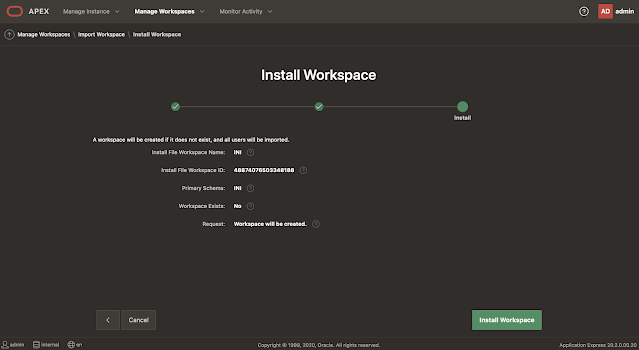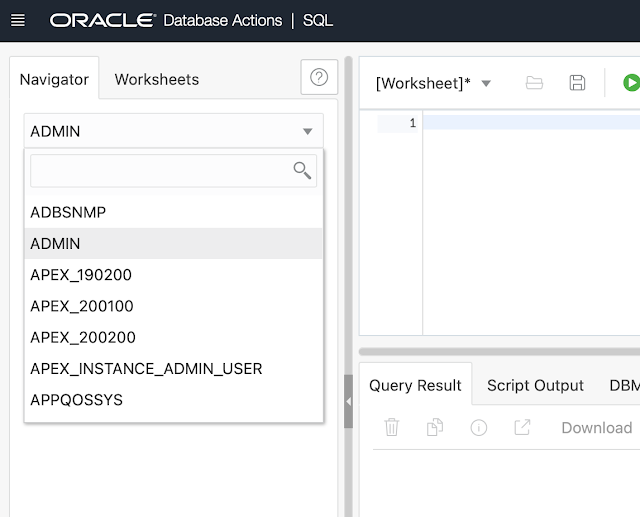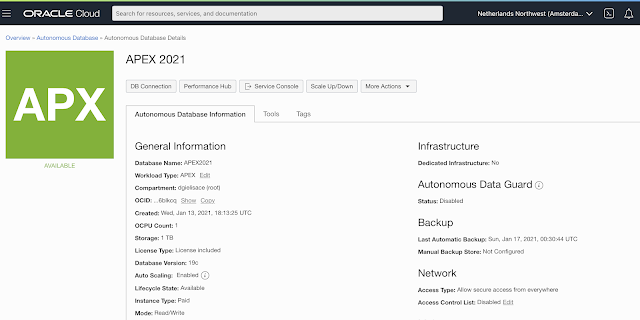This post is part of the series My spin on the new Oracle APEX Application Development Service.
In the
previous post, we set up the environment which provided us everything to start building
Oracle APEX apps. In this post, I want to take the Oracle APEX apps I've built before and move them to this new service.
There are different ways of accomplishing this. Here are the steps I will follow:
- In the current environment
- Export the database (schema)
- Export the APEX app
- On the new Oracle APEX Application Development Service
- Import the database (schema)
- Import/Deploy the APEX app
I will start by moving a very small app I built a few years ago; the reservation of meeting rooms we use in the Innovation and Incubation center in which our office is located.
In our current environment, we will export the data and the APEX app as explained below.
Export the database schema
There are different ways to get your data: export to flat files, make your data available through REST web services or use some other tools to move data. We export all our apps every night to a different location with
Oracle Data Pump. In case you are new to Data Pump, here's the command you can use to export a specific schema:
expdp apex_backup/xxx@apex_pdb directory=DATAPUMP dumpfile=db_20210121_ini.dmp logfile=db_20210121_ini.log schemas=INI exclude=statistics
or export the entire database:
expdp apex_backup/xxx@apex_pdb directory=DATAPUMP dumpfile=db_20210121_full.dmp logfile=db_20210121_full.log full=y exclude=statistics
I like to use Data Pump as it will export everything in one .dmp file and it's really fast to do.
Export the APEX application
Just like with the data, we also export all APEX workspaces and applications every night. We use the APEX Export tool. This is especially useful if you want to move your entire environment to the cloud as you don't have to export workspaces and apps one by one.
The command to export all workspaces:
/usr/bin/java oracle.apex.APEXExport -db localhost:1521/APEX_PDB -user apex_backup -password xxx -expWorkspace > workspaces.txt
The command to export all applications:
/usr/bin/java oracle.apex.APEXExport -db localhost:1521/APEX_PDB -user apex_backup -password xxx -instance > applications.txt
Now that we have the database data pump file (.dmp) and the APEX export file (.sql), we are ready to go to the new APEX Application Development Service to import the database and Oracle APEX app.
Import the database schema
The first thing we will do is import the database into the new service.
Log in to the Oracle Cloud and go to the APEX Application Development > APEX Instances.
From there click on the database link:
Here you arrive in the database. There's a DB Connection button:
Here you normally can download the connection details (credentials/wallet) to your database, which would mean we could follow the same technique as I described in my blog series on the Always Free Oracle Cloud, more specifically on
how to use SQLcl and Data Pump with the Oracle ATP. Although this Oracle APEX Service is based on the same technology as the Always Free ATP, there are some limitations, one is, you can't connect directly to the database from external tools e.g. SQLcl.
I thought as a workaround I would upgrade the service, import the data and downgrade again, but it seems that is not going to fly. Once you upgrade it's irrevocable.
First, we will make the dump file available to the Data Pump API. The database in the Oracle Cloud can not read a file from your filesystem directly, so you have to make the file available so the database can read it. In the Oracle Cloud, we can use Object Storage to store our dump file. In my blog post
Setup Object Storage and use for File Share and Backups, you find step-by-step instructions both to upload through the GUI as from the command line.
As this is a very small database, I will just use the GUI. For anything that is less than 500MB you can most likely use the OCI Console, but for large data pumps the GUI will time out. In case your dump file is bigger, use the OCI REST API or CLI, or SDK.
Go to Object Storage :
Create a Bucket:
I call it db_import:
Click on the new bucket, db_import:
In the bucket, click the Upload button:
Drag-drop the files you want to upload. In my case I will just upload one file db_20210119_ini.dmp:
The uploaded files will appear in the bucket under Objects:
Make sure to copy the URL of the dump file. In order to do so, click the three dots next to the file and click View Object Details
And copy the URL Path (URI):
Now that the file is available, let's create the database (schema).
First, I typically create the user with a script:
create user ini identified by Thisisrealsecure123;
grant connect to ini;
grant create job to ini;
grant create dimension to ini;
grant create indextype to ini;
grant create operator to ini;
grant create type to ini;
grant create materialized view to ini;
grant create trigger to ini;
grant create procedure to ini;
grant create sequence to ini;
grant create view to ini;
grant create synonym to ini;
grant create cluster to ini;
grant create table to ini;
grant create session to ini;
grant execute on ctxsys.ctx_ddl to ini;
grant execute on dbms_crypto to ini;
alter user ini quota unlimited on data;
On the APEX Service dashboard, click the Launch SQL Developer Web, log in and copy and run the above script:
Next, import the data pump file which we stored earlier in Object Storage.
In order to connect to Object Storage from SQL Dev Web we need some Cloud Credentials. Just like in the first post where we created the SMTP credentials, we will now go to that screen to create some Auth Credentials.
Go to Identity > Users and select your user and click the Auth Tokens:
Click the Generate Token button, give it a name and click the Generate Token button:
Copy the created token and hit the close button:
Note that if you lost your token, you can create another token from this screen (and delete the old one):
Go back to SQL Developer Web and create the credentials. This will allow us to connect to other cloud services like the Object Storage:
begin
dbms_cloud.create_credential(
credential_name => 'YourName',
username => 'YourUser',
password => 'YourPassword');
end;
/
In my case it looks like this:
Now we load the file from our Object Storage into the DATA_PUMP_DIR directory where Data Pump can find the dump file to finally do the import. We use the
DBMS_CLOUD package. Use the credentials you created before, use the URL you copied and the directory name should be DATA_PUMP_DIR
begin
DBMS_CLOUD.GET_OBJECT(
credential_name => 'dgielis',
object_uri => 'https://objectstorage.eu-amsterdam-1.oraclecloud.com/n/ax54uj3ardud/b/db_import/o/db_20210119_ini.dmp',
directory_name => 'DATA_PUMP_DIR');
end;
I took a screenshot of some more commands I used to check my environment:
- The first command to check I had credentials (dba_credentials)
- The second to query the Object Storage bucket
- The third to put the object from the Object Storage onto the database machine
- The fourth command to make sure the dump file was in the directory
Ok - now we can start our Data Pump import by using the
DBMS_DATAPUMP API.
declare
ind NUMBER; -- Loop index
h1 NUMBER; -- Data Pump job handle
percent_done NUMBER; -- Percentage of job complete
job_state VARCHAR2(30); -- To keep track of job state
le ku$_LogEntry; -- For WIP and error messages
js ku$_JobStatus; -- The job status from get_status
jd ku$_JobDesc; -- The job description from get_status
sts ku$_Status; -- The status object returned by get_status
begin
-- Create a Data Pump job to do a "full" import (everything in the dump file without filtering).
h1 := DBMS_DATAPUMP.OPEN('IMPORT','FULL',NULL,'INI');
-- Add the file to the job handler
DBMS_DATAPUMP.ADD_FILE(h1,'db_20210119_ini.dmp','DATA_PUMP_DIR');
-- As on the previous system the tablespace was different, I remap the tablespace
DBMS_DATAPUMP.METADATA_REMAP(h1,'REMAP_TABLESPACE','INI','DATA');
-- In case you migrate from a legacy Schema Service, in addition, to remap the
-- tablespace, you may also want to remap the schema to a more user-friendly name
--
DBMS_DATAPUMP.METADATA_REMAP(h1,'REMAP_SCHEMA','DBPTTTBDEG1JF','MYNEWSCHEMA');
-- Start the job. An exception is returned if something is not set up properly.
DBMS_DATAPUMP.START_JOB(h1);
-- The import job should now be running. In the following loop, the job is
-- monitored until it completes. In the meantime, progress information is displayed.
percent_done := 0;
job_state := 'UNDEFINED';
while (job_state != 'COMPLETED') and (job_state != 'STOPPED')
loop
dbms_datapump.get_status(h1,
dbms_datapump.ku$_status_job_error +
dbms_datapump.ku$_status_job_status +
dbms_datapump.ku$_status_wip,-1,job_state,sts);
js := sts.job_status;
-- If the percentage done changed, display the new value.
if js.percent_done != percent_done
then
dbms_output.put_line('*** Job percent done = ' || to_char(js.percent_done));
percent_done := js.percent_done;
end if;
-- If any work-in-progress (WIP) or Error messages were received for the job, display them.
if (bitand(sts.mask,dbms_datapump.ku$_status_wip) != 0)
then
le := sts.wip;
else
if (bitand(sts.mask,dbms_datapump.ku$_status_job_error) != 0)
then
le := sts.error;
else
le := null;
end if;
end if;
if le is not null
then
ind := le.FIRST;
while ind is not null loop
dbms_output.put_line(le(ind).LogText);
ind := le.NEXT(ind);
end loop;
end if;
end loop;
-- Indicate that the job finished and gracefully detach from it.
dbms_output.put_line('Job has completed');
dbms_output.put_line('Final job state = ' || job_state);
dbms_datapump.detach(h1);
end;
/
And here's the result, everything nicely imported:
I switch users and see the tables, and querying the data of a table gives me the data:
When executing the import script in SQL Developer Web (SDW), for large imports, it is possible you will be timed out of SDW before the import job finishes. To monitor the status of the job, you can open another SDW instance and monitor the job.
declare
ind NUMBER; -- Loop index
h1 NUMBER; -- Data Pump job handle
percent_done NUMBER; -- Percentage of job complete
job_state VARCHAR2(30); -- To keep track of job state
le ku$_LogEntry; -- For WIP and error messages
js ku$_JobStatus; -- The job status from get_status
jd ku$_JobDesc; -- The job description from get_status
sts ku$_Status; -- The status object returned by get_status
begin
-- Attach to the Data Pump job
h1 := DBMS_DATAPUMP.ATTACH('IMPORT','INI');
-- Get the Job Status
dbms_datapump.get_status(h1,
dbms_datapump.ku$_status_job_error +
dbms_datapump.ku$_status_job_status +
dbms_datapump.ku$_status_wip,-1,job_state,sts);
js := sts.job_status;
-- check percent done and output to console
percent_done := js.percent_done;
dbms_output.put_line('*** Job percent done = ' || to_char(percent_done));
-- Detach
DBMS_DATAPUMP.DETACH(h1);
end;
In case the status is going bananas, here's a short script you can execute to kill the job if needed.
declare
ind NUMBER; -- Loop index
h1 NUMBER; -- Data Pump job handle
percent_done NUMBER; -- Percentage of job complete
job_state VARCHAR2(30); -- To keep track of job state
le ku$_LogEntry; -- For WIP and error messages
js ku$_JobStatus; -- The job status from get_status
jd ku$_JobDesc; -- The job description from get_status
sts ku$_Status; -- The status object returned by get_status
begin
-- Attach to the Data Pump job
h1 := DBMS_DATAPUMP.ATTACH('IMPORT','INI');
-- Stop the job
dbms_datapump.stop_job(h1, 1);
-- Detach
DBMS_DATAPUMP.DETACH(h1);
end;
Credit to Todd Bottger (update on 30-APR-2021):
-- //start
There are two different ways to get the actual import job done in PL/SQL. Each has tradeoffs.
1) Use of DBMS_CLOUD.GET_OBJECT followed by DBMS_DATAPUMP import from the local file as described above: this approach probably will be the fastest one for large data sets.
The downsides are slightly more complex script (more lines of script) and it consumes extra storage space due to GET_OBJECT making a full local copy first. Note that customers pay for this storage space as part of their storage bill. Of course, the price per TB in APEX Service is quite low, so perhaps it will not be a big concern for most folks.
2) Alternative approach using DBMS_DATAPUMP *only*.
Note that DBMS_DATAPUMP in ADB-S now supports importing directly from OCI Object Storage.
This was implemented in DB 21c and backported to DB 19c for internal patch applied to ADB-S services (including APEX service).
Here and
here are some DB 21c docs that cover it.
I have on good authority from folks here at Oracle that this operation reads data over the network and imports in real-time. There are some internal optimizations like read-ahead caching, but it does not make an additional copy to local disk, which is nice. This approach results in simpler script (fewer lines of code – no need for DBMS_CLOUD.GET_OBJECT) and also avoids consuming the extra storage space.
However, there are performance points to be aware of – i.e. network latencies and some overheads in object storage itself – that probably make it slower than Option A.
It still might be a good approach for when users want the simplest possible PL/SQL script and they are importing a small data set:
DBMS_DATAPUMP.ADD_FILE(h1, 'https://swiftobjectstorage.us-phoenix-1.oraclecloud.com/v1/<objectstoragenamespace>/<bucketname>/<dumpfilename>', 'MYCREDENTIAL', NULL, dbms_datapump.ku$_file_type_uridump_file);
Side note: I believe you can use the <filename>_%U.dmp syntax at the end of such URLs when the export was split across multiple files like export_01.dmp, export_02.dmp, etc. to automatically import them all
-- //end
Now that we have our database (all objects and data), let's import the Oracle APEX app.
First, we have to create the workspace. I tried to find an easy way to run my workspace sql file, but couldn't. For example in SQL Developer on the desktop, I can just run files from a URL, but in SQL Dev Web this is not available yet:
So, I went with the conventional way of importing my APEX Workspace through APEX itself.
Log in to the INTERNAL workspace and click on Manage Workspace - Import Workspace:
Select the workspace file and hit next:
Follow the wizard and select to reuse the schema we already created when we imported the database objects:
Finally hit the Install Workspace button:
The reason I don't create a new workspace, is because I want to take all workspace settings and users from the other system.
Log in to the workspace we just imported. Note that you log in with the ADMIN user, same as INTERNAL:
APEX recognizes it's the first time you log in and it asks to set a password in this workspace:
You can chose one and hit Apply Changes:
And that is it, we are now in our imported Workspace.
Next up, import the APEX application. We could go to App Builder and follow the import wizard.
If you have only a handful of applications, this is definitely a good way. However, if you are moving hundreds of apps to this environment you probably more want to script it.
Here's a way you could do it. I uploaded the APEX app export files also to Object Storage.
In order to use this file in APEX, we create a Pre-Authenticated Request, so basically for a specific amount of time, we can access our file without the need for a password and other credentials.
Follow the wizard and set for example the expiration of the pre-authentication request to 1 extra day:
Now, go back to your APEX workspace and click SQL Workshop > SQL Commands and use the following script:
declare
l_source apex_t_export_files;
begin
l_source := apex_t_export_files (
apex_t_export_file (
name => 'f263.sql',
contents => apex_web_service.make_rest_request (
p_url => 'https://objectstorage../f263.sql',
p_http_method => 'GET' )));
apex_application_install.install(p_source => l_source );
end;
And presto, the APEX app is installed:
Go to the App Builder, and enjoy seeing the APEX app
It turns out to be quite a long blog post to move my database and APEX app to this new environment.
There are probably more ways to do it, so feel free to comment on this blog post with an improved flow.
I also expect in the future it becomes easier. One of the focus points of Oracle APEX 21.1 and further is to make the integration with other Oracle Cloud services easier. If for example Object Storage was known by APEX_APPLICATION_INSTALL or other we would have fewer steps.
That's it for now, next up, configure printing and exporting.
Update 30-APR-2021:
Todd Bottger sent me a few commands which I incorporated in the blog post. Thank you, Todd!






















































































